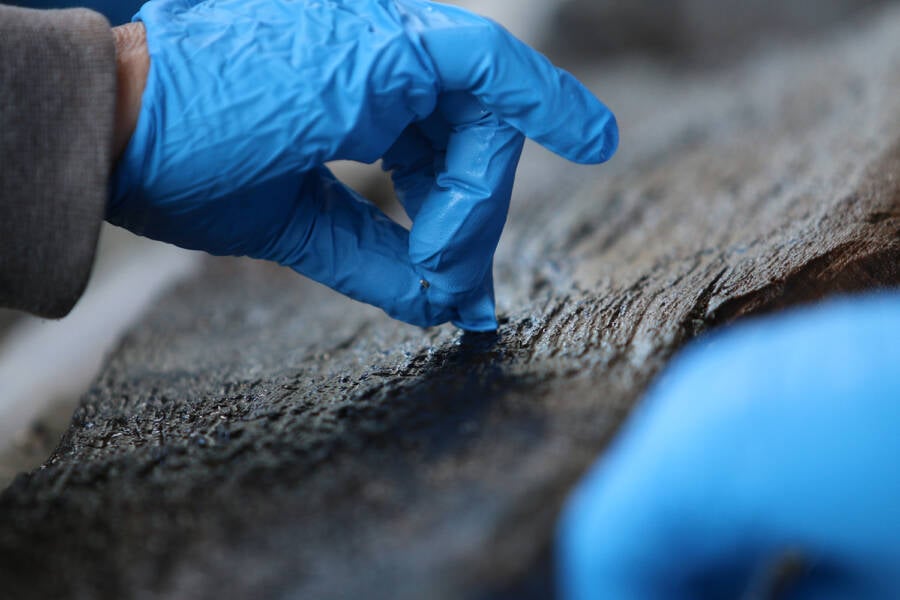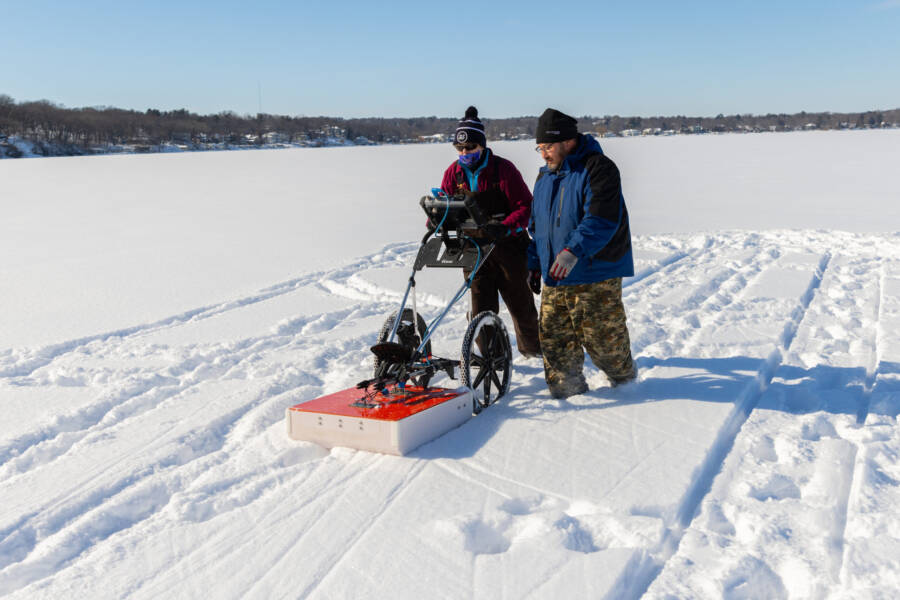Since 2021, researchers from the Wisconsin Historical Society have been finding ancient canoes in Lake Mendota, revealing centuries of Native history.

Wisconsin Historical SocietyMembers of the Wisconsin Historical Society pulling a 1,200-year-old canoe from Lake Mendota in 2021.
Archaeologists from the Wisconsin Historical Society recently made a fascinating discovery at the bottom of Lake Mendota: as many as 11 ancient canoes submerged beneath the lake’s surface. The oldest dugout canoe is estimated to be around 4,500 years old, offering significant new insight into the lives of ancient Native peoples in North America.
This new discovery is just the latest in a series of finds at Lake Mendota. Between 2021 and 2022, archaeologists recovered two canoes dating back 1,200 years and 3,000 years. But the 4,500-year-old canoe officially marks the oldest of its kind ever found in the Great Lakes region.
The Discoveries Of Ancient Canoes In Lake Mendota
Lake Mendota in Madison, Wisconsin is the city’s largest lake. In 2021, maritime archaeologists from the Wisconsin Historical Society set about exploring the lake to see what ancient secrets it might hold. At the time, they stumbled upon a single dugout vessel, believed to be 1,200 years old.
Subsequent dives the following year revealed a similar wooden boat. Researchers believed this canoe to be roughly 3,000 years old, making it the oldest of its kind ever found in the Great Lakes region at the time.

Wisconsin Historical SocietyThe 3,000-year-old canoe pulled from Lake Mendota.
Suspecting that there might be even more artifacts lurking in Lake Mendota’s depths, archaeologists partnered with Native Nations in Wisconsin to conduct further diving expeditions at the site.
“It was becoming clear that we weren’t just looking at one canoe that had sunk, or two canoes — that we had an assemblage, and they might not all be the same,” state archaeologist Amy Rosebrough told the Milwaukee Journal Sentinel.
Now, the Wisconsin Historical Society has announced in a new statement that they have identified fragments of as many as nine additional canoes — the oldest of which is made of elm and is roughly 4,500 years old.

Wisconsin Historical SocietyA close-up view of the ancient, 3,000-year-old canoe discovered in 2022.
The wooden canoe fragments have origins that span millennia, with the oldest dating to 2500 B.C.E. and the most recent, made of red oak, dating to 1250 C.E., meaning it is just shy of 800 years old.
Moreover, this string of discoveries has confirmed researchers’ long-held assumptions that ancient Native peoples traveled throughout the region by dugout in the Late Archaic period.
Researchers believe the canoes’ owners would have intentionally sunk the canoes in shallow water, just offshore, in the autumn in order to preserve them throughout the winter. Then, in the spring, they would have retrieved them and set out in them once more.
These canoes were likely buried as the shoreline changed over the centuries due to natural natural forces like drought and floods.
The canoes raise just as many questions as they answer, however.
“What’s eating away at me, honestly, is: Are there more?” Rosebrough said in an interview with WPR. “Is there a bathtub ring of canoes all the way around Lake Mendota? And that’s just one lake.”
What These Canoes Reveal About The Region’s Ancient Inhabitants
The oldest canoe is providing fascinating new insight into the Late Archaic period.
“You are 2,000 years before farming,” Rosebrough told the Milwaukee Journal Sentinel, providing context about the time in which the canoe was made. “There’s no gardening; it’s 2,000 years in the future. They’re 2,000 years before the first burial mound is built.”
Clearly, the use of these canoes lasted well into the era of farming, but it’s remarkable that the practice goes back to a time when these ideas weren’t even on the horizon.
The canoes were found in the ancestral territory of the Ho-Chunk nation. Researchers believe they were built by the ancestors of modern Indigenous nations, but as Rosebrough noted, these peoples lived “so far back in time that we would be at a complete loss of what they called themselves.”
“The canoes are telling the story of the people who have been here for a very long time, regardless of what they call themselves,” she added.
Two of the canoes come from the Middle Woodland period, during which early farming communities, pottery, and burial mounds were established. By then, some communities had settled down on a long-term basis, and trade routes were being established.
Several others — three or four — came from the Late Woodland period, when corn farming and effigy mounds were far more commonplace. And the most recent canoe came from the Oneota period, which was marked by the establishment of permanent farming communities.

Wisconsin Historical SocietyGround penetrating radar (GPR) analysis is conducted on Lake Mendota by Miranda Washinawatok (left) and Bill Quackenbush.
“Seeing these canoes with one’s own eyes is a powerful experience, and they serve as a physical representation of what we know from extensive oral traditions that Native scholars have passed down over generations,” said Bill Quackenbush, historic preservation officer for the Ho-Chunk Nation. “We are excited to learn all we can from this site using the technology and tools available to us, and to continue to share the enduring stories and ingenuity of our ancestors.”
Researchers said they will continue to study the recovered fragments of the first two canoes, which will be sent to Texas A&M University to be freeze-dried for display in the Wisconsin History Center, set to open in 2027.
The more recent discoveries, however, will remain in place due to their fragile condition. Meanwhile, researchers will continue to explore the area, with plans to use a sonar boat to map the lake.
For now, Rosebrough remarked at how these discoveries are helping people connect more intimately with the region’s ancient history.
“If I show somebody a spearpoint that’s 5,000 years old, it doesn’t really seem to sink in because this isn’t something people have experience with today,” Rosebrough said. “But when you point at a canoe, people go, ‘Oh, I recognize that.’ And then they recognize themselves in that. And then they see the people that go along with that canoe, and they can visualize the life and the deep history here.”
After reading about the canoes found in the depths of Lake Mendota, read about nine of the most powerful Native American warriors in history. Then, see our gallery of 44 striking photographs of Native American life in the early 20th century.





